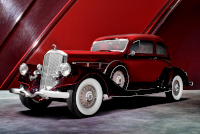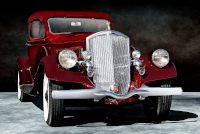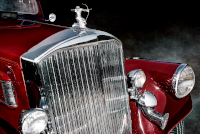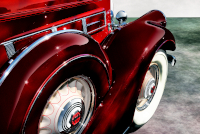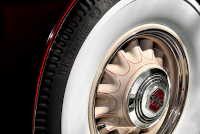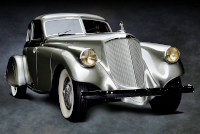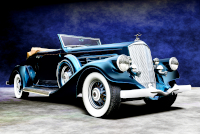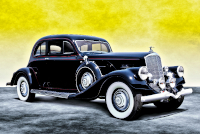Location:
RM Sotheby's, Hershey, 2019
Owner: Mark Hyman | St. Louis, Missouri
Prologue:
Note that ownership has since changed.
This Model 1245 Silver Arrow is one of the more popular examples of the production version in the public eye. What we add here complements the Model 1240A, wrapping up the Silver Arrow story as it began in 1933. But I try not to get carried away, because as incredible as the original show car is, these facsimiles are rather pale. So while it is good to supplement the portfolio with a noteworthy example, I do not find much depth in the exercise. Yesteryear's public may agree. This car may be the only surviving V-12 Silver Arrow from 1935, of such scant production that year.
These are interesting perspectives and portraits, too much under shadow and yet I don't mind the clutter. I am not in a mood to sterilize the pictures too much, now striking the 198th image in the portfolio on the 32nd Pierce-Arrow profiled. So the work feels like tired dedication without the enthusiasm to make a perfect image; these are okay, a little bit cut-cornery. I do like the nose portraits. Lots of pop and sparkle. And the foreshortened, locomotive-like perspective. The rest preserve a windy-sunny glare, a part of that October afternoon I certainly enjoyed. Sometimes I don't like to lie about a car's native environment, and rather let the light quality speak about the true time and place. In that sense, I this set is alright.
- - - - - - - - - -
► Image Source: Nikon D750 (24.3 MP)
References:
- Ralston, Marc. "Pierce-Arrow" A.S. Barnes & Co., Inc., San Diego, CA. 1980, page 180, 194, 232
- Automobile Quarterly, Volume 28, Number 4, Fourth Quarter 1990, "The Last Years of Luxury" by John C. Meyer III, The Kutztown Publishing Company, Inc., Kutztown, PA, page 97
- RM Sotheby's: The description from RM Sotheby's 2019 Hershey auction.
- Hymand LTD: A second description and suitably thorough inside-out gallery by competent photographic hands.
Though we discussed the 1935 production year with the Model 1245 Convertible Coupe Roadster, and we covered the broad differences between the Silver Arrow show car and the production version that followed in 1934, the points to reinforce are i.) Pierce-Arrow built even fewer of these coupes in 1935, and ii.) the choice to build a two-door coupe on a decently large chassis distorts the proportions of the original show car.
To the first point, in this car we might see the lone surviving example of a 1935 Model 1245 Silver Arrow, the V-12, whereas at least one 1935 Model 845 with the 385 cubic inch straight-8 also survives—that car a two-tone tan example. An imposing two-door coupe falls outside the wants of typical Pierce-Arrow clientele, and by 1935 the company's sales capacity has been clipped by the terms of its bankruptcy, which disposed of the Pierce-Arrow Sales Corporation and limited units that could be built in spite of orders. While Pierce-Arrow fulfilled less of its potential as a result of bankruptcy, there would have been no production otherwise. And whatever margin the company lost would not have mattered had they been able to build and sell at capacity. The Depression ran too deep.
To the second point, what was an eccentric show car became a modest production vehicle, at least in comparison. The product is still a V-12 Pierce-Arrow with all its rightful claims to land speed records and extraordinary roadworthiness. But the lines are now upset. Whereas the show car used a 139-inch wheelbase to execute a streamlined four-door sedan, the production car rides on a larger 144-inch wheelbase with conventional running gear. A taller, top hat shape conceals some of the bulk, keeping the coupe motif within reasonable proportions, but not of the same proportions as the elegant original.
The Model 1240A and Model 1245 Silver Arrow cars are therefore special, but only to an extent. They are rare, but these are cars of interest for the lost riches they represent, whereas the original show car is one of the most significant automotive designs ever conceived by any designer, of any marque, in any country. The common party line, that the production car draws heavily on the original Phillip O. Wright design, is simply incorrect. The platforms are different, the concept is different, and the execution is completely conventional in lieu of the original's extreme cost.
Known from RM Sotheby's, Hyman LTD, Pebble Beach, and the CCCA, chassis #405002 appears today as it had following a 1990s restoration commissioned by Harris Laskey. Laskey was a partner of Laskey-Weil Co. LLC, founded in 1957, an apartment and hotel development firm active in Los Angeles during the latter half of the 20th century; they remain in operation today. While not uncommon to find Laskey references attached to classic era American cars, neither RM nor Hyman make any citation of the original owner. We're left with a contemporary impression, then—not insignificant, just cursory compared to its show car origins.
Motor: 7,570 cc (462 cubic inch) 80° V-12, cast-iron block | 88.9 mm x 101.6 mm (3½" x 4")
Valvetrain: L-head, 2 valves per cylinder, with self-adjusting hydraulic tappets
Aspiration: Stromberg dual downdraft carburetor
Power: 175 bhp @ 3,400 rpm
Drivetrain: 3-speed gearbox with freewheeling, rear-wheel drive
Front Suspension: solid axle, semi-elliptic leaf springs, friction dampers
Rear Suspension: live axle, semi-elliptic leaf springs, friction dampers
Architecture: steel ladder frame chassis with steel body over wood frame
Wheelbase: 3,657.6 mm (144 inches)
The Silver Arrow show cars used the smaller 139-inch wheelbase; they are four-door sedans. For the production version of the Silver Arrow concept, Pierce-Arrow turned to the 144-inch wheelbase, but then designed a two-door coupe on the longer platform. Given the change in dimensions and plan, the proportions of these later productions cars are necessarily far different than those of the original.
Etymology:
In 1935, Pierce-Arrow add a '-5' nomenclature to its models. Thus, the 1934 Model 1240A becomes the 1935 Model 1245. (The wayward 'A' designation of 1934 disappears without having demonstrated any purpose.) As had the alphanumeric '1240A,' the '1245' number corresponds to V-12 models that use either the 139 or 144-inch wheelbase chassis. The '12' refers to the motor, while '45' compromises on how best to reference the short and medium-length chassis options, but rather ending in '-5' as a nod to 1935 in lieu of any technical reasoning. In turn, styles riding on the big 147-inch wheelbase chassis are now the Model 1255.
The Salon Twelve moniker appears in Pierce-Arrow promotional material. We re-print the moniker here for continuity with the 1934 Model 1240A Silver Arrow. The factory seemed not to need the distinction, 'Eight' or 'Twelve' being sufficient. But such is the world of sales, and in this case the term is a slight Packardization of the model line. For the final few years of Pierce-Arrow production, model designations will become very much Packardized, beginning with the 1936 Model 1601.
The Silver Arrow name descends to the production line from the inimitable Silver Arrow show car of 1933, of which Pierce-Arrow built five. Impossible to replicate at scale, the production version is less an evocation of that eccentric art piece than a false copy.
Figures:
Hyman LTD suggest that two Silver Arrows survive from a very small lot of four produced in 1935; they do not distinguish between the straight-8 Model 845 and V-12 Model 1245, but it is possible (at least at a glance) that only one of each remains. Pierce-Arrow built and sold more of the style in 1934, of which roughly 14 survive.
Value:
This Model 1245 Silver Arrow sold at RM Sotheby's 2019 Hershey auction for $198,000.
Top Hat: Broad and High Design
We comment on the top hat shape in our profile of the 1934 Model 1240A Silver Arrow. The height grows to accommodate rear-seat passengers within a two-door plan, far different from the show car's sleek lines and four-door body that fits smoothly over the sill rails. Instead, conventional running boards and fenders create a brim for this top hat. The windscreen is a single flat-pane glass unit as opposed to a vee. The sides sit upright, and the slant-back hood is rather broad. Not so much the tapertail as the show car, the production Silver Arrow at least offers a respectable boot.
Carried Over: 1935 Silver Arrow Updates
The 1935 model retains 1934 styling with the exception of the bonnet side panel, which aligns three vents within a new chrome frame, replacing the triangular pattern of the previous year. A new gauge cluster also updates the interior, not illustrated here. The rest is comparable to the Model 1240A. Still we find subtle differences between examples. I am not sure whether Pierce-Arrow offered wheel covers, as seen on chassis #400229 from 1934, but so few examples from this 1934-35 period wear wheel covers that the question is academic. These may or may not be original. In any case, this 1935 car uses the Budd steel artillery wheel option, which contrasts the body very nicely with coffee-cream paint and red pinstripes. This 1935 car also uses a door-mounted rear-view mirror in lieu of the spare-mounted fixtures on the 1934 car, and does without the added Trippe Safety Lights.
Nose News: Body-Matched and Chromed Radiator Shrouds
A more interesting anomaly is that this 1935 Model 1245 should use a radiator shroud color-matched to the body. Instead, the radiator unit is fully chromed like the 1933 cars. This difference could stem from the car's 1990s restoration, though it is not the only Pierce-Arrow of the 1934-35 period to use a fully chromed radiator unit. Customization had always been part of Pierce-Arrow's ever-so-careful art department, but whether a chrome shroud spotted on a car decades down the road is part of its original equipment or a late owner's predilection is pure speculation.
Red Tales: Pierce-Arrow Proportions Relative to the Fire Engines that Followed
The two-tone red body somewhat inadvertently hearkens back to Seagrave's 1938 purchase of Pierce-Arrow engineering following the company's final bankruptcy. From this point, the Karl Wise V-12 will power Seagrave fire engines for the next four decades. Such is the strength of the design and the uncanny shadow cast by this Silver Arrow. And one should not be fooled by the two-door platform. Riding on a 144-inch wheelbase, this Silver Arrow coupe is as big as its sedan and limousine cousins, no small car. The two-tone livery does well to break up the size into digestible pieces, with darker sail panels extending from the binding down to the tail, (better viewed on the 1934 Model 1240A). These panels are simple compared to the compound shapes used on the Silver Arrow show car, and the tail is flat in comparison to accommodate a practical boot. The hood line kinks at the top for head room and stays steep down to the bumper, losing the show car's fastback elegance and lithe tapertail. Hyman LTD present more accurate colors in their gallery but the effect is rather similar—a lot of steel coated in shifting burgundy hues.
Last Updated: Mar 26, 2025

